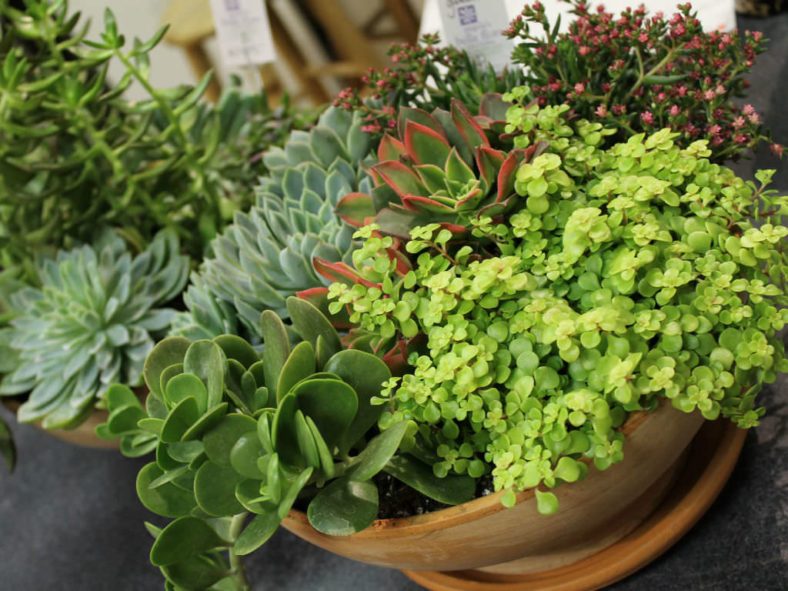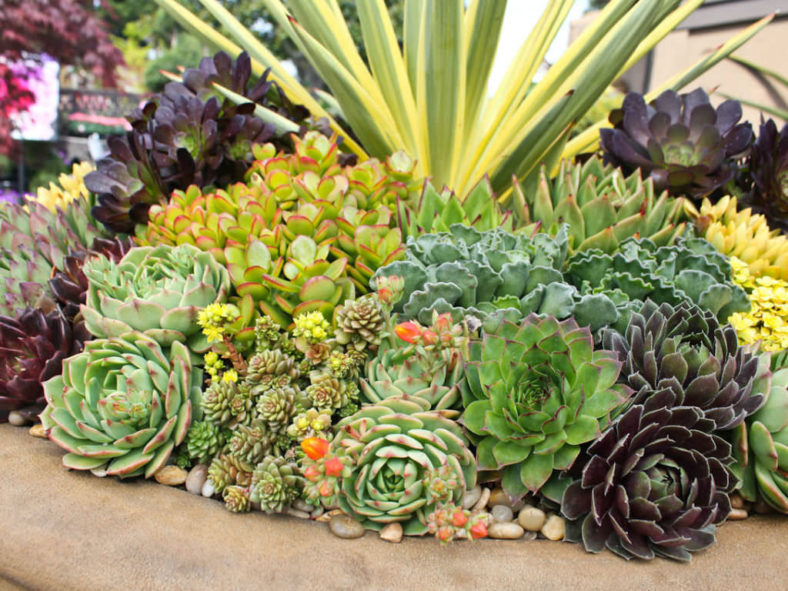Succulents are popular plants in both containers and landscapes for a good reason. They are low maintenance, drought-tolerant, and super easy to maintain. Even "brown thumb" types can keep a succulent alive.
These plants are also popular because they are so beautiful in their own surreal way. They may come from all over the world, but most look like they come from outer space or deep beneath the sea. Their strong architectural forms, gorgeous colors, and intriguing textures will bring out your inner artist, and their seemingly infinite variety will tempt you to become a collector. Very few people can stop after just one succulent!
Soil
All succulents require excellent soil drainage. This means the water should run through the pot fast so the roots do not get waterlogged. Succulents can die from being planted in ordinary potting soil. When potting succulents, use bagged soil labeled as being for cacti and succulents. It is easily found at most nurseries.
If you want to mix your own soil, you will find many recipes available in books and on the Internet and will have to decide which one works best for you. Some of the most common recommendations are mixing potting soil 1:1 with perlite. You could also mix ordinary potting soil 1:1 with sharp sand (also called builder's sand). Or you could try 2 parts potting soil to 1 part perlite to 1 part tiny gravel. If you squeeze a handful of moist soil in your fist and let it go, it should not hold shape but fall apart.

Water
Succulents are adapted to survive in harsh, dry conditions by storing water in their flesh. However, this does not mean they do not like water when they can get it. They are a little like camels in this way! The one major tip for growing succulents is that they do not like being soggy. Therefore, you are far more likely to kill your succulent by overwatering it than by underwatering it.
Let the soil in the pot dry out a little between waterings. In general, you would want to give your plants just enough water to keep their leaves plump and no more. It is hard to generalize, but this may mean giving potted plants a drink once every week or so, depending on conditions. A pot on a hot patio may appreciate more water than one kept indoors. A small pot dries out faster than a big pot. Plants need more water in summer than in winter. Touch the soil to find out if it is dry or not. Succulents in the ground will want water every two weeks or so, again, depending on conditions. Remember, it is better to let them get a little dehydrated than to overwater them.
When you water, water until the water soaks through and comes out the bottom of the pot. It is important to have fast-draining soil so the pot's bottom does not get waterlogged.
Signs of overwatering: Leaves become squishy and change color, becoming paler, even white, or perhaps brown. You will see the rot in the roots if you lift the plant out of its pot. To rescue the situation, cut off the healthiest looking parts and repot them in dryer soil.
Signs of underwatering: When stressed for water, succulents use the water in their leaves and stems, giving them a thin, wrinkled appearance. This is not as serious as the rot from overwatering. They will plump up again after a good watering. They are amazingly resilient but not indestructible, and if they go too long without water, they will drop all their leaves.
Note: Some succulents go dormant during portions of the year and do not want to be watered during this time.
Light
Succulents evolved in dry climates but should not be confused with tough desert cacti. Generally speaking, full sun outdoors is okay for Aloes and Agaves, but Echeverias prefer a bit of shade or dappled sunlight. Most succulents appreciate some shade during the hottest part of the day.
You can keep potted succulents indoors, but they do not do well in dim light situations. So instead, try to find a sunny window for them and give them "sun vacations" outdoors.
Signs a plant is getting too much light: The leaves may scorch, have brown, black, or white patches, or just look burnt or withered. When stressed by the bright sun, green succulents may turn pretty red and yellow. This is attractive but also signals that you should pay close attention to ensure they do not get too stressed. Consider moving the pot to a less sunny location.
Sign a plant is getting too little light: A plant desperate for the sun will reach or lean toward the light. Sometimes it will throw a lot of energy into elongating its stem as if it would stretch out the window to better light. This is what is called "getting leggy."

Legginess is a sure sign of light starvation. Leggy plants can be trimmed into a more attractive form and repotted, then moved somewhere brighter. Unfortunately, light-deprived plants can also become generally sickly and more susceptible to insect infestation.
If you decide to move a pot to brighter light, particularly if moving it indoors to outdoors, give it some time to adjust. Let it spend its first few days outdoors in the shade, then in the dappled sun. Moving it straight into full sun might shock the plant and cause it to burn.
Pests
Succulents are pretty tough, but they can still have insects and other pests. Snails and mealybugs are two common foes.
Containers
Succulents adapt well to many types of containers, from fancy ceramics to funky found art objects. They are shallow-rooted, as a rule, so that they can thrive in containers too shallow for regular plants. The one important rule for containers is that they should have drainage holes. These days, it is trendy to pop succulents into all sorts of containers, like canning jars or antique vases, but if the container does not have a drainage hole at the bottom, you will be at high risk for overwatering your plants.
The good news is that you can make a drainage hole in almost anything with an electric drill. There are specialty drill bits of different materials, including glass and ceramics. Ask your local hardware store for a bit, which will match your container. While at the hardware store, buy some 3-in-1 oil and use it on ceramic bits to keep them from smoking. Metal containers are perhaps the easiest to work with. You can make holes in tin cans and old metal containers with a hammer and nail.
If you skip the drainage hole, water sparingly and hope for the best. In such cases, taller containers work better than shallow ones because the water tends to gather in the low parts of the pot, so short-rooted succulents have some hope of keeping their feet dry if all the water sinks to the bottom of a deep pot. It is also okay to treat your succulents more like cut flowers and put together temporary arrangements, for instance, a table centerpiece. You do not have to worry about drainage, light, or anything else in these cases.
Temperature
Your outdoor plants should be fine down to 40 °F (4.5 °C) or slightly lower. Freezing temperatures can damage succulents, except for certain Sedums and Sempervivums, which are cold-tolerant. If you hear there will be a frost, bring your potted succulents inside or into a shelter, like a garage. In places with frosty winters, succulents need to be potted up and moved to shelter from the entire winter.
Source: rootsimple.com
Links
- Succupedia: Browse succulents by Scientific Name, Common Name, Genus, Family, USDA Hardiness Zone, Origin, or cacti by Genus